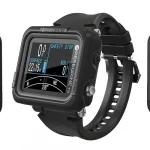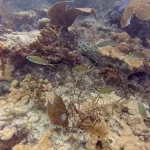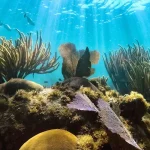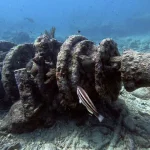Table of Contents
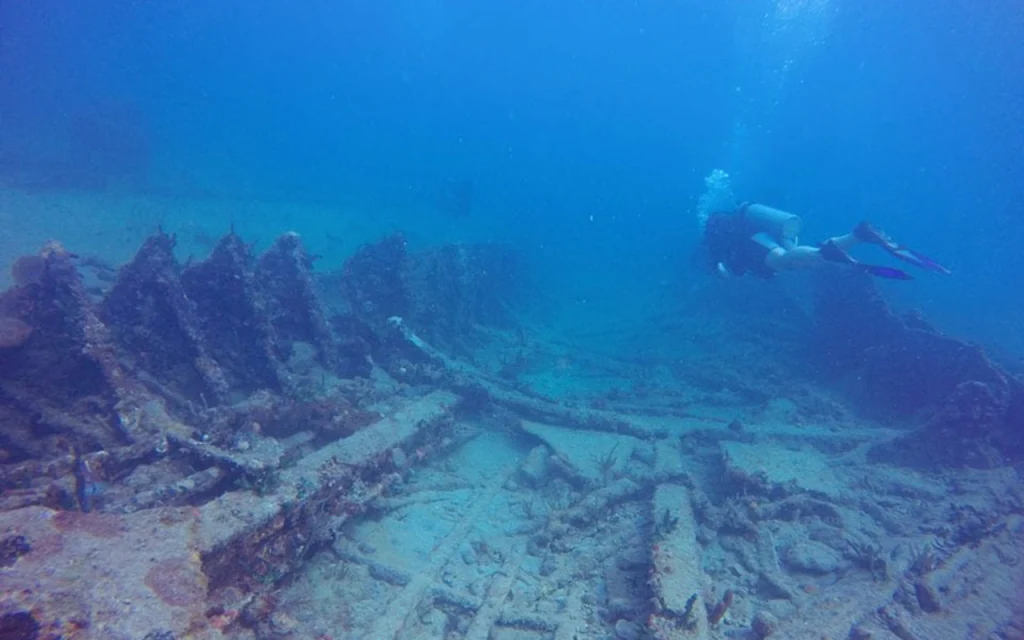
The SS Copenhagen combines shallow depths ideal for all levels, plentiful marine life, historical shipwreck artifacts, preserved archaeological status, and convenient accessibility – creating a truly unique Florida Keys wreck diving experience.
Article at a Glance
- The SS Copenhagen was a 325 ft long steel steamship that ran aground in 1900 off Lauderdale-by-the-Sea, Florida while carrying 4,940 tons of coal
- The wreck rests in 16-31 ft of water on a reef ledge, with depths varying across 300 ft of scattered wreckage
- Located 3/4 mile offshore at GPS coordinates 26°12.349’N, 80°05.108’W, the wreck is part of a Florida Underwater Archaeological Preserve
- Divers report abundant marine life including corals, sponges, sea fans, tropical fish, moray eels, parrotfish and nurse sharks inhabiting the wreck
- The shallow depths make the wreck ideal for recreational diving of all experience levels
- After failed attempts to free the ship, it was abandoned as a total wreck valued at $250,000
- The wreck remained visible above water for some time and was used for target practice by the U.S. Navy during WWII before sinking
Shipwreck Depth and Diving Coordinates
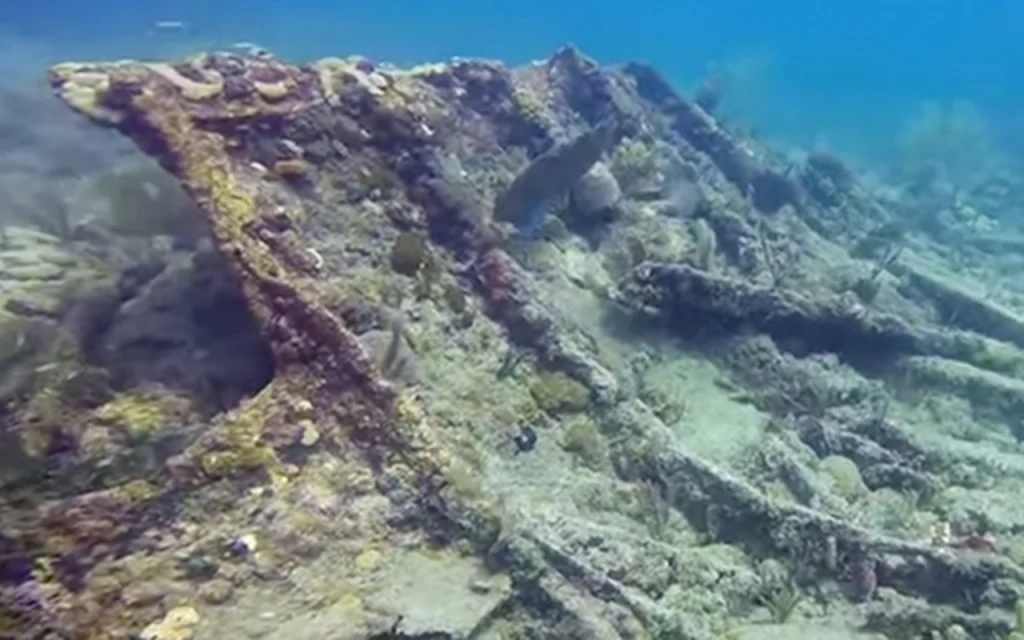
Diving Depth
As for depth, the wreckage is scattered over an area of approximately 300 feet, with the depth varying from:
The 16-31 foot depth range, makes it an ideal recreational dive spot accessible to all experience levels. The varying depths are due to the wreck resting on an uneven rocky reef ledge.
Location and Coordinates
- Approximately 3/4 mile (0.82 yards) offshore from Lauderdale-by-the-Sea/Pompano Beach, Florida
- 3.3 nautical miles south of Hillsboro Inlet
- Just outside the second reef on the “Pompano Drop Off” adjacent to mooring buoys 3 and 4
- LORAN Coordinates: 14269.7, 62103.7
- GPS Coordinates: 26°12.349’N, 80°05.108’W
What Scuba Divers Say About This Shipwreck
Scuba divers have shared several positive experiences diving the SS Copenhagen shipwreck site. Here are some of the key points they highlight:
Great for All Experience Levels
Being in relatively shallow depths of 15-30 feet, the Copenhagen is considered an ideal wreck dive for open water and novice divers to explore safely and gain experience.The shallow depth and broken up nature make it very accessible.One diver notes “Since the wreck is only in 25 feet of water, Copenhagen is a great site for new divers to explore.”
Abundant Marine Life
Over a century underwater, the wreckage has become an artificial reef covered in coral, sponges and sea fans, teeming with tropical fish, moray eels, parrotfish and even nurse sharks taking shelter. Divers enjoy the vibrant marine ecosystem surrounding the wreck.”There is an abundance of marine life that resides in the area. It is common to see large schools of fish, morays, parrotfish and more.”
Identifiable Artifacts
Despite being scattered, divers can still make out recognizable artifacts like the large anchor, donkey boiler used for cargo equipment, propeller shaft pillow block, cargo boom remnants, and sections of the double hull. Exploring these features provides insight into the ship’s construction.”You can really see how the ship has become part of the coral reef it struck back in 1900.”
Archaeological Preserve Status
As a designated Florida Underwater Archaeological Preserve with an on-site plaque, divers appreciate the historical context and preserved status of the Copenhagen wreck site. One diver shared photos highlighting the plaque.Overall, scuba divers find the SS Copenhagen an enjoyable and accessible wreck dive with plenty of marine life, historical artifacts to explore, and shallow depths suitable for all experience levels.
What Kind of Marine Life Can Be Found Around This Shipwreck
Divers can expect to see a diverse array of marine life inhabiting the SS Copenhagen shipwreck site, including:
- Hard and soft corals covering the wreckage
- Sponges
- Sea fans swaying amid the twisted steel structure
- Tropical fish darting in and out of the wreck
- Large schools of fish
- Moray eels taking shelter in crevices
- Parrotfish
- Nurse sharks resting among the wreckage
Divers highlight that over the past century, the Copenhagen has become well-established as an artificial reef teeming with marine life. As one diver states: “There is an abundance of marine life that resides in the area. It is common to see large schools of fish, morays, parrotfish and more.”
Another diver notes “Coral growth is everywhere…Sea fans sway and soft corals decorate the hull.”
The wreck’s cracks, sheltered areas, and coral cover provide ideal habitat for fish and invertebrate species to thrive.The Copenhagen’s protected status as an Underwater Archaeological Preserve has allowed this vibrant artificial reef ecosystem to flourish over time, making it an oasis of biodiversity for divers to explore amid the historical wreckage.
Key Information
| Detail | Information |
|---|---|
| Ship Details | – Steel-hulled, schooner-rigged steamship – Built in 1898 in Sunderland, England – 325 feet long, 47 feet wide, 25.6 feet depth – Powered by 3 triple expansion steam engines – 3,279 ton tonnage |
| Sinking | – Ran aground on reef 3/4 mile offshore on May 26, 1900 – Carrying 4,940 tons of coal from Philadelphia to Havana – Cause was improper navigation by captain – Abandoned as total wreck valued at $250,000 |
| Current State | – Rests in 16-31 feet of water on reef ledge – Bow facing south – Became artificial reef, part of Florida Underwater Archaeological Preserve |
| Diving Depth | – 16-31 feet depth range, ideal for recreational diving – Varying depths due to uneven rocky reef ledge |
| Location | – 3/4 mile offshore from Lauderdale-by-the-Sea/Pompano Beach, Florida – 3.3 nautical miles south of Hillsboro Inlet – Outside 2nd reef on “Pompano Drop Off” near mooring buoys 3 & 4 – LORAN: 14269.7, 62103.7 – GPS: 26°12.349’N, 80°05.108’W |
| Marine Life | – Abundant marine life: corals, sponges, sea fans – Tropical fish, moray eels, parrotfish, nurse sharks |
| Dive Experience | – Great for all experience levels due to shallow depths – Identifiable artifacts like anchor, boiler, propeller shaft – Appreciated as historical preserve |
What Makes The SS Copenhagen a Unique Diving Experience
Ideal for All Experience Levels
Being in relatively shallow depths of 15-30 feet, the Copenhagen is an excellent wreck dive for open water and novice divers to explore safely. At the same time, its size and features make it engaging for experienced divers as well.
Abundant Marine Life
Over a century underwater, the wreckage has become an artificial reef covered in coral, sponges, and sea fans, teeming with tropical fish, moray eels, nurse sharks and other marine life. This vibrant ecosystem surrounding the wreck creates an immersive diving experience.
Identifiable Shipwreck Features
Despite being broken apart, divers can still make out recognizable artifacts like the large anchor, donkey boiler, propeller shaft pillow block, cargo boom remnants, double hull sections, and even the ship’s mast. Exploring these features provides insight into the Copenhagen’s construction and final voyage.
Archaeological Preserve Status
As a designated Florida Underwater Archaeological Preserve and listing on the National Register of Historic Places, the Copenhagen wreck is an protected historical site with an informative plaque providing context. This preserved status enhances the educational experience.
Convenient Location
The wreck’s location just 3/4 mile offshore from the Pompano Beach area allows easy access for dive charters and even shore dives from the beach. This proximity makes it a popular local dive destination.So in summary, the SS Copenhagen combines shallow depths ideal for all levels, plentiful marine life, historical shipwreck artifacts, preserved archaeological status, and convenient accessibility – creating a truly unique Florida Keys wreck diving experience.
How Does The SS Copenhagen Compare To Other Shipwrecks in Florida
Shallow Depth
At depths of 15-30 feet, the Copenhagen is one of the shallowest major wreck dives in Florida, making it accessible to divers of all experience levels, especially open water and novice divers. Many other notable Florida wrecks lie in deeper waters.
Artificial Reef Ecosystem
Over the past century, the Copenhagen has developed into a thriving artificial reef teeming with marine life. Divers report seeing abundant hard and soft corals, sponges, sea fans, tropical fish, moray eels, parrotfish, nurse sharks and more inhabiting the wreckage. The wreck’s status as an Underwater Archaeological Preserve has allowed this ecosystem to flourish.
Historical Significance
The Copenhagen is one of only 12 Florida wrecks designated as an Underwater Archaeological Preserve by the state due to its historical significance. It was added to the National Register of Historic Places in 2001. Divers can explore recognizable artifacts like the anchor, donkey boiler, propeller shaft, cargo boom and double hull that provide insight into early 20th century steamship technology.
Accessibility
The Copenhagen’s location just 3/4 mile offshore from Pompano Beach makes it one of the most accessible major wreck dives in Florida, with many local dive charters offering trips to the site. Its proximity allows even shore dives from the beach in some cases.
Popularity
With an estimated 10,000 visitors per year, the SS Copenhagen is by far the most popular underwater preserve in Florida. Its combination of shallow depth, marine life, historical interest and accessibility make it a must-dive site for many Florida visitors and residents.So in summary, the SS Copenhagen stands out for its shallow depth, thriving artificial reef, historical significance, accessibility and popularity compared to other Florida wreck dives. Its unique attributes make it a top destination for divers of all levels to explore a well-preserved piece of maritime history.
The History of This Ship
Construction and Early Years
The SS Copenhagen was a steel-hulled, schooner-rigged steamship built in 1898 by J Priestman & Co in Sunderland, England. It was 325 feet long, 47 feet wide, 25.6 feet deep, and had a tonnage of 3,279 tons. It was powered by three triple expansion steam engines rated at 312 NHP, giving it a speed of 8 knots. It also had masts rigged for sailing as a schooner.
The Copenhagen was completed in March 1898 for the Glasgow Shipowners’ Company Ltd, who appointed Glen & Co to manage the ship. It was registered at Glasgow, Scotland with the official number 108711 and code letters QBNL. The ship was used to haul cargo across the Atlantic.
Final Voyage and Wreck
On May 20, 1900, the Copenhagen departed Philadelphia carrying 4,940 tons of coal bound for Havana, Cuba with a crew of 26 under Captain William Jones. On the night of May 25-26, after passing the Jupiter Inlet Light off Florida, Jones ordered a course change to south-southeast to stay offshore.
At around 9am on May 26, the Copenhagen struck the Pompano Dropoff reef about 3/4 mile offshore from present-day Lauderdale-by-the-Sea at full speed. The engines were stopped and reversed, but the ship remained stuck on the reef.
Over the next two days, the crew began unloading the coal cargo to try and refloat the ship with the help of local workers and salvage vessels. However, all attempts failed, and the Copenhagen, valued at $250,000 with its remaining $12,500 cargo, was abandoned as a total wreck on the reef.
An inquiry found Captain Jones at fault for improper navigation and not taking soundings, though his certificate was not suspended due to his service record.
What Historical Features Can Still Be Identified On The SS Copenhagen Wreck
Several historical features of the SS Copenhagen shipwreck can still be identified by divers today:
- The large anchor at the southern end of the wreckage site
- The donkey boiler used to power the ship’s cargo equipment
- The pillow block that supported the propeller shaft
- Remnants of the cargo boom
- Sections of the double hull, which was a safety feature to prevent sinking in the event of a collision
- The ship’s mast, a relic of the schooner rigging used to supplement the steam engines
Despite being broken apart over the past century, these recognizable artifacts provide insight into the construction and final voyage of the 325-foot cargo steamship built in 1898. Exploring these features gives divers a sense of the ship’s history and the era of transition from sail to steam power.
The SS Copenhagen’s designation as a Florida Underwater Archaeological Preserve also enhances the educational experience, with an informative plaque marking the site and historical context provided to visitors. Diving this well-preserved wreck allows one to turn back the clock and discover maritime history firsthand.
What Safety Measures Are in Place for Divers Visiting the SS Copenhagen
Here are some key safety considerations for diving this wreck:
Shallow Depths
With depths ranging from 15-30 feet, the SS Copenhagen is considered a relatively shallow wreck dive, which reduces risks associated with deeper dives. The shallower depths make it more accessible to divers of all experience levels, including open water certification.
Designated Underwater Archaeological Preserve
As a designated Florida Underwater Archaeological Preserve, the SS Copenhagen wreck site is an officially recognized and protected area. This status implies there are likely mooring buoys, boundary markers, and guidelines in place to ensure the site’s preservation and diver safety.
Abundant Marine Life
While the vibrant marine ecosystem around the wreck adds to the dive experience, the presence of marine life like moray eels and nurse sharks necessitates appropriate diver awareness and precautions.
Experienced Dive Operators
The popularity of the SS Copenhagen wreck with an estimated 7,000-10,000 annual visitors suggests local dive operators and charters are very familiar with the site and can provide appropriate safety briefings and oversight.
Proximity to Shore
The wreck’s location just 3/4 mile offshore from Pompano Beach allows relatively quick access for emergency response if needed, compared to more remote wreck sites.While not explicitly stated, standard wreck diving safety protocols would likely be in place, such as proper gear checks, buddy system, avoiding entry/exit risks, monitoring depth/air consumption, and adhering to diver certification limits for the conditions encountered. The site’s shallow depths, protected status, experienced operators, and shore proximity provide a reasonably controlled environment for divers when appropriate precautions are taken.
Dive Shops That Provide Diving Trips to This Shipwreck
Here are the dive shops/operators that offer diving trips to the SS Copenhagen shipwreck:
- Pompano Dive Center
Located in Pompano Beach, this dive center frequently takes snorkelers and scuba divers out to the SS Copenhagen wreck site. They operate three dive boats – Sea Dog Diver, Sea Siren, and Sea Pup Diver – that can accommodate between 10-28 divers per trip to the wreck. - Local dive charters from Pompano Beach, Deerfield Beach and Fort Lauderdale
Dive charters from Pompano Beach, Deerfield Beach and Fort Lauderdale often visit the shallow SS Copenhagen wreck, which is popular with divers and snorkelers.
Multiple dive operators in the Pompano Beach/Fort Lauderdale area run trips to this well-known and accessible wreck site located just 3/4 mile offshore.
The SS Copenhagen’s status as a designated Underwater Archaeological Preserve, its shallow depths of 15-30 feet, abundant marine life, historical significance, and proximity to shore make it an attractive dive destination for local charter businesses to include in their offerings.
South Florida Wrecks
- SS Copenhagen
- Captain Dan Wreck
- SS Arratoon
- Queen of Nassau
- USS Mohawk
- MV Castor
- Esso Bonaire III
- St. Jacques
- The Gilbert Sea
- Shasha Boekanier
- Thozina
- The Orion
- The DEMA Trader
- Ancient Mariner
- The Amaryllis
- The Ande
- USS Hydro Atlantic
- Zion Train
- Mercedes I
- Half Moon
- The Danny
- The Ultra Freeze
- The Doc DeMilly
- Jay Scutti
- The Tracy
- Sea Emperor
- Jim Atria
- Merci Jesus
- Princess Britney

